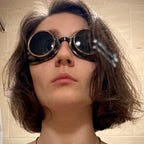Part One: Trapped Priors & Perceptual Evidence
This will require several parts to address the theory of psychopathology I refer to, the use of different drugs in this regard, the tech I had in mind and probably many more things… Let’s try one thing at a time.
First, I want to briefly explain what the deal with the trapped priors is and why we would need artificially created perceptual experiences for psycho-therapeutic purposes. You can find much more information, reviews and discussion of this topic here, here, and here.
What are these Trapped Priors anyway?
Neuroscience and (to some extent) psychology make use of Bayesian probability by approximating human brain as a predictive machine, where all cognition is a combination of priors, such as expectations or memories, and new evidence — sensations (or perceptions, depending on definition). Together they produce perception — and your priors get updated in the process.
According to one take on different psycho-pathological models, in some cases of psychopathology, especially depression, anxiety, PTSD and neuroticism, your Bayesian brain assigns too low weights to perceptual input. Your prior is likely in a state of negative bias and, since sensory input is not processed “properly” — the prior is not getting updated. In other words — it is trapped. An example might be something like a case of severe mistrust in people, which is manifested in constant expectation of “rug-pulling”, provoking anxiety and depressive states. This could be a genetic predisposition or trauma-induced conditioning or a combination of these & other factors. In this case, the person suffering from such states might encounter countless instances in which they could indeed trust other people, were not betrayed, abandoned etc. However, because their brain gives little weight to new evidence, their prior — the expectation of getting hurt — is not being updated, in spite of all the evidence that it should! This is quite frustrating. The perceptual evidence is not registered properly and the condition is not improving. Scott Alexander also points out that this might be the very reason many people report perceiving the world as “grey” when they have a depressive episode, and as “more colorful” when they get better. Turns out, this might not be simply the depressed audience’s favorite metaphor, they quite literally mean it!
So what does immersive tech has to do with trapped priors?
The idea I want to explore is — whether artificially created and professionally curated perceptual experience can help un-trap them and train the brain to give more weight to sensory evidence. Psychedelics seem to do that on their own, that is, without any specific therapy-form or strategy pedaled by the therapist (or a guide, depending on the setting). Psychedelics-aided therapy seems to work pre-theoretically. Despite the recognized physical safety of magic trips — there are more than enough reasons they will not be widely accessible as a means of therapy for a while, even though there is some good observational evidence and even some promising early attempts to institutionalize their use in some places. I’d want to write a separate post about it and potential advantages of applying immersive tech for similar purposes instead of psychedelics, so more on that later.
For now it seems that a solution might lie in fixing the brain’s assessment of perceptual input. This includes not only visual input, but pretty much every sensory and perceptual modality, from hearing to feeling of your own body in space and the feeling of touch. Everything needs to be paid more attention to by the brain. The question is — how do we make the brain pay attention?
